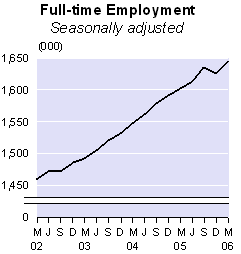

17 March 2006
|
Unemployment in NZ March 2006
The official unemployed rates are an internationally
recognised figure for unemployment based on the
Household Labour Force Survey run by Statistics
New Zealand.
March 2006 seasonally adjusted 86,000 people
March 2006 seasonally adjusted 3.9% OR ONE IN 26 PEOPLE
IN LAST THREE MONTHS December 2005 to March 2006 8,000 people .
RISE IN NUMBER OF UNEMPLOYED
Source — Statistics NZ
REGIONS WITH A DROP IN UNEMPLOYMENT
REGIONS WITH NO CHANGE IN UNEMPLOYMENT
REGIONS WITH A RISE IN UNEMPLOYMENT
(formerly Winz)
PEOPLE REGISTERED AS JOB SEEKERS
NOTIFIED VACANCIES
Source — Ministry of Social Development
March 2006
NUMBER OF PEOPLE IN JOBS IN NEW ZEALAND
RISE IN THE NUMBER OF PEOPLE IN JOBS IN LAST 3 MONTHS
RISE IN THE NUMBER OF PEOPLE IN JOBS IN LAST YEAR
SECTORS WITH A RISE IN EMPLOYMENT IN LAST YEAR
GAIN IN FULL-TIME EMPLOYED
 IN THE PAST YEAR March 2005 to March 2006 10,000 people
Unemployed by sex
SPAIN 8.7%
"Those without a job
These "Jobless" figures are also based on the
Household Labour Force Survey run by Statistics NZ,
but include a wider definition of unemployment,
usually referred to "those without a job and wanting
a job".
According to Statistics NZ, the difference between the official "unemployment" figures and the "jobless figures" is that many of the people on the jobless measurement are available for work, but not actively seeking it. The reasons for not actively seeking work range from people being discouraged because they lack the skills needed, or were the wrong age, or that the right work was not available in their area, or they were only looking for jobs in their newspaper. This measurement also includes those actively seeking work but not yet available for it.
OFFICIAL NUMBER OF JOBLESS IN NZ
OFFICIAL RATE OF JOBLESS
RISE IN NUMBER OF JOBLESS
NO CHANGE IN NUMBER OF JOBLESS
Source — Statistics NZ
LABOUR FORCE PARTICIPATION RATE
Source — Statistics NZ
MAORI RATE OF UNEMPLOYMENT
PACIFIC ISLAND RATE OF UNEMPLOYMENT
NZ EUROPEAN (PAKEHA) RATE OF UNEMPLOYMENT
Source — Statistics NZ
Source — figures from Ministry of Social Development (formerly Work & Income NZ),Tertiary Education Commission (formerly Skill NZ) and Youth Affairs
|
OFFICIAL UNEMPLOYMENT IN NEW ZEALAND REGISTRATIONS AT WINZ THE UNDER-EMPLOYED THE EMPLOYED FULL-TIME AND PART-TIME GLOBAL UNEMPLOYMENT RATES OFFICIALLY JOBLESS LABOUR FORCE PARTICIPATION RATE RACE / ETHNIC UNEMPLOYMENT AGE RATES AND LONG-TERM UNEMPLOYMENT SCHEMES AND SUBSIDISED JOBS
Unemployment Seasonally adjusted Unemployment Rate Employment Seasonally adjusted
| ||||||||||||||||||||||||||||||||||||||||||||||||||||||||||||||||||||||||||||||||||||||||||||||||||||||||||||||||||||||||||||||||||||||||||||||||||||||||